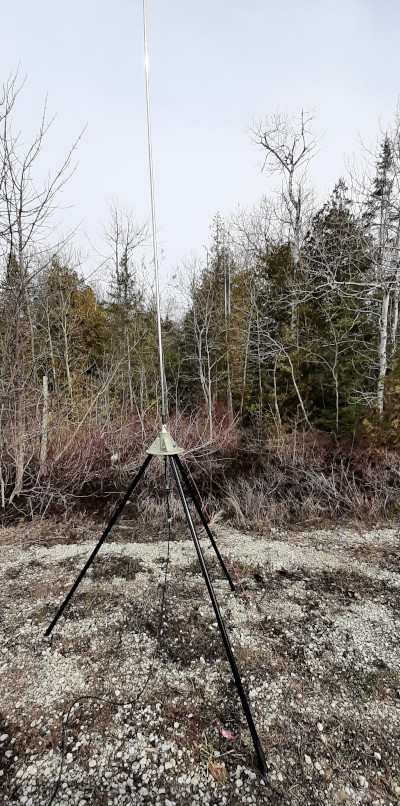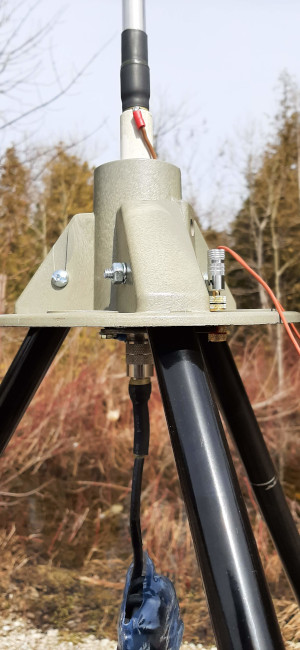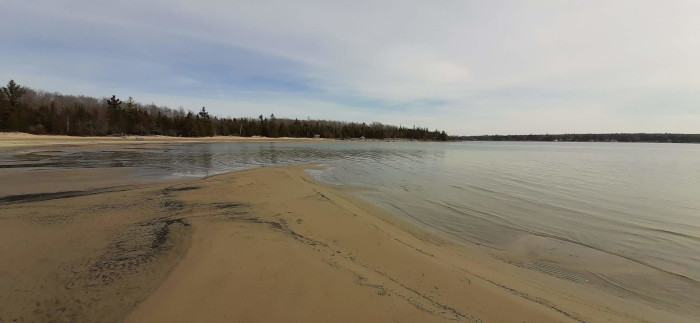In my post https://hamradiooutsidethebox.ca/2024/02/28/field-testing-the-antenna-called-long-tall-sally-oops-and-downs/ I wrote:
Now what if it were possible …
… to maintain the small footprint on the ground while simultaneously reducing the height of the antenna. Could it be done? That’s a project I am working on now. I have some ideas that I think are going to work. Stay tuned.
Now I am pleased to confirm that it is possible to reduce the height of a Most Unusual Vertical Antenna for 20m. First let’s review the the reasons for doing this. The objective is to create a low profile field expedient, rapidly deployable antenna for activities like POTA. Conventional portable, ground-mounted quarter-wave vertical antennas require a large radial field. The radials do not have to be resonant; they are de-tuned by proximity to ground anyway. But, even non-resonant radials can occupy too big a footprint. In my field operations I had been using four 13ft radials so my station footprint was a circle 26ft in diameter. In a busy public space that kind of footprint is “ungood”.
As previously discussed in prior posts, a vertical antenna’s performance can be improved by raising the feedpoint above ground. Just a couple of raised radials will then do the same job as 8 or more ground radials. If those 2 raised radials are sloped downwards at 45 degrees, the feedpoint impedance will be close to 50 ohms.
Just a cotton pickin’ minute!

The geometry of a 20m quarter-wave vertical with resonant radials sloped at 45 degrees requires a feedpoint height of 12ft plus ground clearance. The footprint on the ground will still be around 26ft, albeit now reduced to 2 dimensions (refer to the figure). The overall antenna height works out to over 29ft. It might be a more efficient antenna but we didn’t gain much in terms of footprint.
The “Long Tall Sally” design introduced in a recent post improves these limitations by shrinking the length of the radials (from 17ft down to 5ft) while increasing the length of the radiating element from 17ft to 25ft. If the feedpoint is raised 4ft above ground the overall antenna height is still around 29ft but the footprint on the ground is now reduced to just 7ft. Oh, and it works; I used Long Tall Sally for a successful recent POTA activation.
Very good; but now make it even better!
So the challenge evolved into taking a successful field antenna design and reducing its height while maintaining the low horizontal footprint. This was done by using an inductively-loaded whip. The addition of a coil at the base of the whip increases its electrical length. I have a Chinese telescopic whip that is 18.5ft long so I added a 2.6 microhenry coil I had already built for another of my madcap experiments.
Now, remember, the vertical is longer a quarter-wave in length, so how can we find out its electrical length? Buried in the vaults of human knowledge there is probably a complex mathematical formula for calculating the length. But I am both impulsive and impatient. Yes I could go scouring through my very old college physics textbooks and maybe also check out some electrical engineering (“plumbing” as we physics undergraduates used to call it) books but I had a simpler idea.
At 66pacific.com there is an online calculator for finding the size of inductor needed for a base-loaded QUARTER WAVE antenna. My base-loaded vertical antenna is NOT a quarter wave – it has been stretched. Can I still use the online calculator? Some years ago the idea of “lateral thinking” was popular. If that principle is applied to this problem there is a simple solution. My antenna comprises an 18.5ft whip with a 2.6 microhenry loading coil. It isn’t resonant on 14MHz, but it must be resonant somewhere in the electromagnetic spectrum. So, I plugged several parameters into the online calculator to find out where. I came up with 9.1 MHz.
So how long would a quarter wave whip be if it is resonant on 9.1MHz? The answer is basic entry-level ham exam math: 234/9.1 = 25.7ft. That is very close to the length of the unloaded vertical element of Long Tall Sally (25ft).
Keep in mind, we are not interested in an antenna that is resonant on 9.1MHz; our antenna is going to be resonant on 14MHz after the addition of 2 sloping tuned raised radials. Long Tall Sally uses 5ft radials but the shortened version achieves best SWR with two 6.25ft radials. Such are the vagaries of the mysterious world of electromagnetrickery.
The antenna, my friend, is blowing in the wind

The end result of all this tinkering is a self-supporting vertical antenna that occupies a very small footprint on the ground and is resonant on 20m. My Ukrainian RigExpert friend gave me an SWR of 1.6:1 which is just fine. The length of the radials can be adjusted for fine tuning in the field. No trees are required for support and no stakes in the ground. I mounted it for testing on a small tripod. The center of gravity of this shortened version is much lower and there is less wind resistance so – unlike Long Tall Sally – it is far less likely to topple over.
One more observation: the overall height has been reduced by about 6 feet. It could be reduced even more by increasing the loading coil inductance. I may try this at some point, but further shortening will increase its Q and narrow its bandwidth. It remains to be seen whether that trade-off would be justified.
How does it compare with Long Tall Sally?
Pros and cons? Long Tall Sally can be hung from a tree limb where that is not a problem. It is very light and packs away in a small canvas pouch. The shortened version requires either a tripod or a short support pole that can be secured to a fence post and may be less convenient to carry into the backcountry. Both antennas will accompany me on my outdoor operating trips this year so we’ll see which earns the most deployments.
First Field Deployment

In these images we can see the new antenna during a POTA activation at CA-0155 Black Creek Provincial Park 12 March 2024. It worked fine business with 22 good contacts over much of the United States.



Back to the future
I have been corresponding by email with several Ham Radio Outside the Box readers to discuss ideas arising out of posts on this blog. One reader, Tom Pierce K8EBR, has been particularly helpful in getting me started on the road to learning 4NEC2 antenna modeling. Tom gave me an idea for a “hiking antenna” that I found very intriguing. I am working on that idea and may be able to report on it some time in the future.
Your comments and suggestions are most welcome!

at Winter Field Day 2024
Help support HamRadioOutsidetheBox
No “tip-jar”, “buy me a coffee”, Patreon, or Amazon links here. I enjoy my hobby and I enjoy writing about it. If you would like to support this blog please follow/subscribe using the link at the bottom of my home page, or like, comment (links at the bottom of each post), repost or share links to my posts on social media. If you would like to email me directly you will find my email address on my QRZ.com page. Thank you!
The following copyright notice applies to all content on this blog.

This work is licensed under a Creative Commons Attribution-NonCommercial-NoDerivatives 4.0 International License.